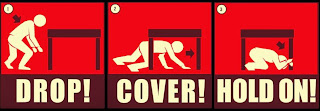Week 3 explores earthquakes and what countries do to prevent/mitigate the hazard. If I want to know something about earthquakes in a place, the first websites I go to are: the USGS Real Time Earthquakes Website or the IRIS monitoring website.
Regarding where quakes are located in the US, this seismicity map below from USGS shows the (obvious, in hot pink) ring of fire portion on the West coast but also a central area in the middle of the plate. I’d like to talk a bit more about this non-obvious one. This area, called the New Madrid Zone was shaken by a M8(!) in 1811. The reason for the activity is a very old intraplate rift placed below the area (see image from http://showme.net).
The San Andreas Fault System is responsible for most of California natural quakes...Each year the southern California area has about 10,000 earthquakes.!! The latest swarm of quakes in the Salton Sea has been featured in the news often. Earthquakes up to magnitude 4.6 under the Salton Sea are raising concern that a larger quake could be unleashed on the San Andreas fault. The southernmost section of the fault has not ruptured since about 1680.
So, what can we do about it?; apart from the obvious need for education, I want to focus on the USGS ShakeAlert system, developed for the West coast using some of the existing systems. Today, the technology exists to detect earthquakes, so quickly, that an alert can reach some areas before strong shaking arrives. The purpose of an EEW (Earthquake Early Warning) system is to identify and characterize an earthquake a few seconds after it begins, calculate the likely intensity of ground shaking that will result, and deliver warnings to people and infrastructure in harm’s way. Studies of earthquake early warning methods in California have shown that the warning time would range from a few seconds to a few tens of seconds, depending on the distance to the epicenter of the earthquake.
There is an Earthquake Tracker all Californians can download to keep informed: try My Shake App.
A few seconds of warning could make all the difference (enough to stop transit/elevators and to drop, cover, hold on).
Being aware of the risk and know what to do when the shaking starts is very important. We know that earthquakes cannot be predicted (I recommend Dr. Jones’ book called the big ones’ if you want more information about that)


I enjoyed reading your blog. I did not know that there were ten thousand earthquakes every year! I'm glad that most of them I cannot feel. I also thought the drop, cover, and hold picture was a good reminder of what to do in an earthquake. Is that the first thing you should do, or should you exit the building if you can?
ReplyDelete(On a side note, in the beginning of the week three slides video, you talk about the 2019 Ridgecrest Earthquake. That was the earthquake that I was in. I lived in Ridgecrest at the time that it happened around the red dot area [it was measured 7.1 where I lived]).
Amazing you were so close to that quake!-wow
ReplyDeleteThere was some very interesting information in this blog post that really intrigued me, such as the theory that a rather large earthquake might be released upon the San Andreas fault yet again. I also thought that it was interesting that all of California is in a danger zone, ranging from hot pink to a small bit of green. It surprises me, therefore, that I've only ever experienced one earthquake and it lasted for maybe 30 seconds? Crazy how the world works!
ReplyDelete